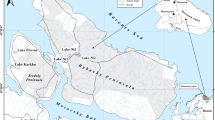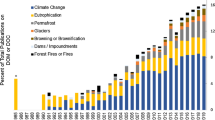Abstract
The paper focuses on the effect of ponds (geographically isolated wetlands) on water quality within internally drained areas in a river catchment. The important part of the study was the point of formation of a periodic hydrographic network of internally drained areas linked with a main river as well as the identification of the circulation pattern of ions in such a system. The aim of the study was to examine the extent to which ponds pollute the main river upon physical connection with it. Research has shown that ponds participate actively in material circulation—including that of water and biogenic ions. The hydrographic network in Young Glacial areas is subject to very large seasonal changes. In the study area, the total length of the stream network in the dry season equaled 12 km, while in the wet season almost 75 km. At the same time, almost 50% of the internally drained areas in the catchment became connected with the surface runoff network. Such large seasonal changes in the hydrographic network yield large changes in stream water chemistry. In the study area, only 6 ponds were linked to the stream network during the dry season, while in the wet season, this number increased to 125. The parts of catchments featuring the largest changes in the hydrographic network as well as the largest number of ponds temporarily linked with surface runoff networks were characterized by a high content of total nitrogen and phosphorus—up to 244.2 kg N km2 per month and 26.2 kg P km2 per month.





Similar content being viewed by others
References
Bachmann, R. W., Bigham, D. L., Hoyer, M. V., & Canfield Jr., D. E. (2012). Factors determining the distributions of total phosphorus, total nitrogen, and chlorophyll a in Florida lakes. Lake and Reservoir Management, 28(1), 10–26.
Bogacka, A., & Taylor, R. (1997). Nutrient non-point pollution in experimental watersheds in Poland. In G. A. Best, T. Bogacka, & E. Niemirycz (Eds.), International river water quality. Pollution and restoration (pp. 146–155). London: E&FN Spoon.
Brant, M. (1990). Simulation of runoff and nitrate transport from mixed basins in Sweeden. Hydrology Research, 21, 13–34.
Brooks, T. R. (2004). Weather-related effects on woodland vernal pool hydrology and hydroperiod. Wetlands, 24(1), 104–114.
Brooks, R. T. (2005). A review of basin morphology and pool hydrology of isolated ponded wetlands: implications for seasonal forest pools of the northeastern United States. Wetlands Ecology and Management, 13, 335–348.
Burger, M., van Vuren, J. H. J., de Wet, L., & Nel, A. (2019). A comparison of water quality and macroinvertebrate community structure in endorheic depression wetlands and a salt pan in the Gauteng province, South Africa. Environmental Monitoring and Assessment, 191, 14. https://doi.org/10.1007/s10661-018-7121-5.
Choiński, A., Ptak, M., & Ławniczak, A. (2016). Changes in water resources of polish lakes as influenced by natural and anthropogenic factors. Polish Journal of Environmental Studies, 25(5), 1883–1890.
Consortium MGGP and IOŚ (2010). Formulation of restrictions on the use of waters of lakes or reservoirs and the use of their catchments in the conditions of using the waters of the water region, Cracow (manuscript in Polish).
de Vicente, I., Amores, V., & Cruz-Pizarro, L. (2006). Instability of shallow lakes: a matter of the complexity of factors involved in sediment and water interaction? Limnetica, 25(1-2), 253–270.
Duan, K., Caldwell, P. V., Sun, G., McNulty, S. G., Zhang, Y., Shuster, E., Liu, B., & Bolstad, B. V. (2019). Understanding the role of regional water connectivity in mitigating climate change impacts on surface water supply stress in the United States. Journal of Hydrology, 570, 80–95.
Fang, G., Yang, J., Chen, Y., Li, Z., & De Maeyer, P. (2017). Impact of GCM structure uncertainty on hydrological processes in an arid area of China. Hydrology Research, 49(3), 893–907.
Ferrant, S., Oehler, F., Durand, P., Ruiz, D., Salmon-Monviola, J., Justes, E., Dugast, P., Probst, A., Probst, J. L., & Sanchez-Perez, J. M. (2011). Understanding nitrogen transfer dynamics in a small agricultural catchment: Comparison of a distributed (TNT2) and a semi distributed (SWAT) modeling approaches. Journal of Hydrology, 406(1–2), 1–15.
Fu, B., Xu, P., Wang, Y., Yan, K., & Chaudhary, S. (2018). Assessment of the ecosystem services provided by ponds in hilly areas. Science of the Total Environment, 624(15), 979–987.
Gebrehiwot, S. G., Di Baldassarre, G., Bishop, K., Halldin, S., & Breuer, L. (2019). Is observation uncertainty masking the signal of land use change impacts on hydrology? Journal of Hydrology, 570, 393–400.
Gerke, H. H., Koszinski, S., Kalettka, T., & Sommer, M. (2010). Structures and hydrologic function of soil landscapes with kettle holes using an integrated hydropedological approach. Journal of Hydrology, 393(1–2), 123–132.
Golus, W., & Bajkiewicz-Grabowska, E. (2016). Water circulation in the moraine ponds of northern Poland. Hydrobiologia, 793, 55–65.
He, J., Balasubramanian, R., Burger, D. F., Hicks, K., Kuylenstierna, J. C. I., & Palani, S. (2011). Dry and wet atmospheric deposition of nitrogen and phosphorus in Singapore. Atmospheric Environment, 45(16), 2760–2768.
Heathwaite, A. L., & Dils, R. M. (2000). Characterising phosphorus loss in surface and subsurface hydrological pathways. The Science of the Total Environment, 251(252), 523–538.
Helcom. (1998). The third Baltic Sea pollution load compilation. Baltic Sea Environment Proceedings, 70, 1–134.
Kalettka, T., & Rudat, C. (2006). Hydrogeomorphic types of glacially created kettle holes in North-East Germany. Limnologica, 39(1), 54–64.
Koc, J., Kobus, S., & Glińska-Lewczuk, K. (2010). The significance of oxbow lakes for the ecosystem of afforested river valleys. Journal of Water and Land Development, 13a, 115–131.
Lehsten, D., Von Asmuth, J., & Kleyer, M. (2011). Simulation of water level fluctuations in kettle holes using a time series model. Wetlands, 31, 511–520.
Lepistö, A., Kenttämies, K., & Rekolainen, S. (2001). Modeling combined effects of forestry, agriculture and deposition on nitrogen export in a northern river basin in Finland. Ambio: A Journal of the Human Environment, 30(6), 338–348.
Lepistö, A., Granlund, K., Kortelainen, P., & Räike, A. (2006). Nitrogen in river basins: sources, retention in the surface waters and peatlands, and fluxes to estuaries in Finland. Science of the Total Environment, 365(1-2), 238–259.
Lischeid, G., & Kalettka, T. (2012). Grasping the heterogeneity of kettle hole water quality in Northeast Germany. Hydrobiologia, 689(1), 63–77.
Loÿe-Pilot, M. D., Martin, J. M., & Morelli, J. (1990). Atmospheric input of inorganic nitrogen to the Western Mediterranean. Biogeochemistry, 9(2), 117–134.
Major, M., & Cieśliński, R. (2015). Retentivity as an indicator of the capacity of basins without an outlet to accumulate water surpluses. Polish Journal of Environmental Studies, 24(6), 2503–2514.
Major, M., & Cieśliński, R. (2017). Impact of hydrometeorological conditions on the chemical composition of water in closed-basin kettle ponds: a comparative study of two postglacial areas. Journal of Elementology, 22(1), 151–167.
Marks, L., Gałązka, D., & Woronko, B. (2016). Climate, environment and stratigraphy of the Pleistocene last glacial stage in Poland. Quaternary International, 420, 259–271.
Morison, M. Q., Macrae, M. L., Petrone, R. M., & Fishback, L. A. (2017). Hydrology drives chemical synchronicity in subarctic tundra ponds. Biogeosciences Discussions. https://doi.org/10.5194/bg-2017-142.
Muster, S., Heim, B., Abnizova, A., & Boike, J. (2013). Water body distributions across scales: a remote sensing based comparison of three arctic tundra wetlands. Remote Sensing, 5(4), 1498–1523.
Ocampo, C. J., Oldham, C. E., Sivapalan, M., & Turner, J. V. (2006). Hydrological versus biogeochemical controls on catchment nitrate export: a test of the flushing mechanism. Hydrological Processes, 20(20), 4269–4286.
Petrone, R. M., Silins, U., & Devito, K. J. (2007). Dynamics of evapotranspiration from a riparian pond complex in the Western Boreal Forest, Alberta, Canada. Hydrological Processes, 21, 1391–1401.
Pietruszyński, Ł., & Cieśliński, R. (2018). The effects of different land use and hydrological types on water chemistry of young glacial ponds. Journal of Hydrology, 564, 605–618.
Rast, W., & Lee, G. F. (1983). Nutrient loading estimates for lakes. Journal of Environmental Engineering, 109(2), 502–517.
Ruiz, M., & Velasco, J. (2010). Nutrient bioaccumulation in Phragmites australis: management tool for reduction of pollution in the Mar Menor. Water, Air, and Soil Pollution, 205(1-4), 173–185.
Smol, J. P., & Douglas, M. S. (2007). Crossing the final ecological threshold in high Arctic ponds. Proceedings of the National Academy of Sciences, 104(30), 12395–12397.
Srinivas, R., Singh, A. P., Gupta, A. A., & Kumar, P. (2018). Holistic approach for quantification and identification of pollutant sources of a river basin by analyzing the open drains using an advanced multivariate clustering. Environmental Monitoring and Assessment, 190, 720. https://doi.org/10.1007/s10661-018-7073-9.
Terasmaa, J., Puusepp, L., Vandel, E., Marzecová, A., Koff, T., Vaasma, T., & Kangur, M. (2016). Main drivers affecting the Holocene sedimentary record – implications from small lake in Latvia. Baltica, 29(1), 63–78. https://doi.org/10.5200/baltica.2016.29.07.
Tiner, R. W. (2003). Geographically isolated wetlands of the United States. Wetlands, 23(3), 494–516.
Valiela, I., Collins, G., Kremer, J., Lajtha, K., Geist, M., Seely, B., Brawley, J., & Sham, C. H. (1997). Nitrogen loading from coastal watershed to receiving estuaries: new method and application. Ecological Applications, 7, 358–380.
Waldon, B. (2012). Natural value and endangerment of small water reservoirs in the Krajeńskie Lakeland (North-West Poland). Limnologica, 42, 320–327.
Xie, Y., Xiong, Z., Xing, G., Yan, X., Shi, S., Sun, G., & Zhu, Z. (2008). Source of nitrogen in wet deposition to a rice agroecosystem at Tai lake region. Atmospheric Environment, 42(21), 5182–5192.
Author information
Authors and Affiliations
Corresponding author
Additional information
Publisher’s note
Springer Nature remains neutral with regard to jurisdictional claims in published maps and institutional affiliations.
Rights and permissions
About this article
Cite this article
Pietruszyński, Ł., Cieśliński, R. Circulation patterns of biogenic ions in Young Glacial areas. Environ Monit Assess 193, 19 (2021). https://doi.org/10.1007/s10661-020-08799-w
Received:
Accepted:
Published:
DOI: https://doi.org/10.1007/s10661-020-08799-w




